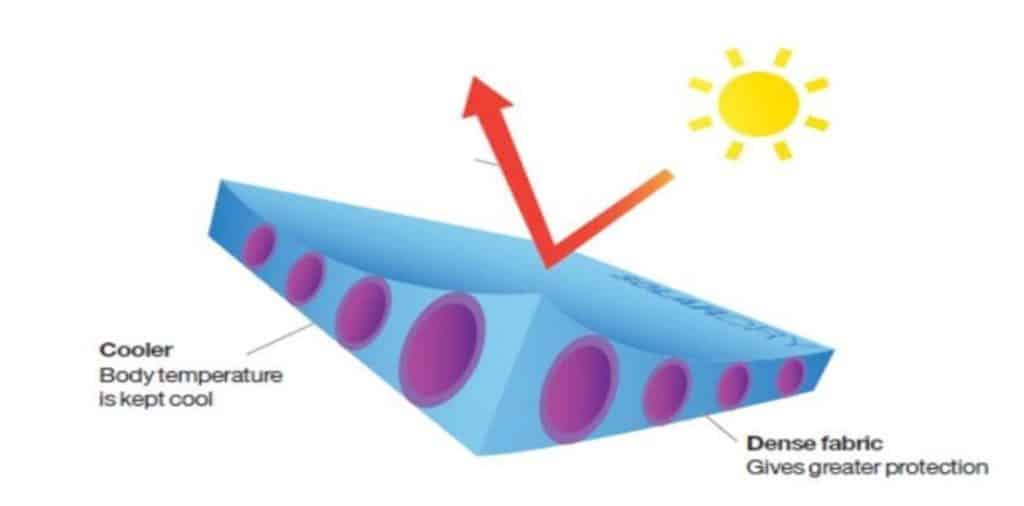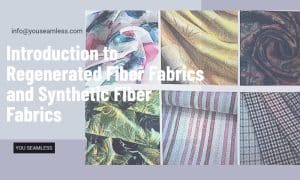What is the best fabric for activewear?
Currently, the most cost-effective and popular fabric for activewear on the market is a blend of 20% spandex and 80% nylon. However, depending on your personal preferences, the type of sport, and the environment in which you exercise, different sportswear fabrics can offer varying performance benefits. Below is a list of common sportswear fabrics along with their pros and cons.
-
Breathability and moisture absorption

During exercise, the body produces a large amount of sweat. By selecting activewear fabrics with good breathability and moisture absorption, clothes can be kept dry and comfortable. Common fabrics with good breathability include:
① Cotton Fabric:
Cotton fabric is a classic breathable and hygroscopic fabric. It can absorb sweat and quickly evaporate, keeping the body dry. Cotton fabric has good breathability and high comfort, especially suitable for low-intensity sports and daily wear. However, cotton fabrics may become heavier after moisture absorption and have a longer drying time, which may cause discomfort when subjected to high-intensity exercise.
② Polyester fabric:
Polyester fabric is a Synthetic fiber with good air permeability and moisture absorption. It can quickly absorb sweat and help it evaporate quickly through the evaporation on the surface of the fabric. Polyester has lightweight and soft properties, while also drying quickly, making it suitable for high-intensity sports. However, polyester fabrics may generate static electricity, and breathable polyester fabrics may cause discomfort in high-temperature environments.
③ Nylon Fabric:
Nylon fabric is also a kind of Synthetic fiber with excellent air permeability and moisture absorption. It can quickly absorb sweat from the skin and evaporate quickly, keeping the body dry. Nylon fabrics are usually very lightweight and durable, suitable for high-intensity and long-term exercise. However, nylon fabrics typically do not possess the softness and comfort of natural fabrics.
④ High tech breathable fabric:
In addition to traditional sportswear fabrics, there are now some innovative high-tech breathable fabrics, such as high-performance polyester and spandex blended fabrics. These fabrics adopt special textile techniques, which have excellent breathability and moisture absorption and can quickly expel moisture from the body and keep it dry. In addition, these fabrics often have antibacterial, odor-resistant, and UV-resistant functions, which can provide additional protection.
In summary, although there are differences in breathability and moisture absorption among various fabrics, cotton, polyester, and nylon fabrics all have a certain degree of breathability and moisture absorption. Choosing the appropriate fabric based on the intensity of exercise and personal preferences is the key to ensuring comfort. For high-intensity sports, high-tech breathable fabrics may be a more ideal choice, while cotton and polyester fabrics can also provide a comfortable wearing experience in daily sports or leisure activities.
-
Elasticity and Supportability

In sports, we need both freedom of movement and appropriate support. Choosing fabrics with elasticity and support, such as elastic nylon and spandex, can better wrap muscles and provide additional support. This will help reduce muscle fatigue and exercise injuries. Common fabrics with elasticity and support include:
① Spandex Fabric:
Spandex is a synthetic Elastic fiber, also known as Elastic fiber or Lycra. Spandex has excellent elasticity and resilience, providing high stretch and comfort. It can closely fit the body contour, providing athletes with appropriate support and compression force. Spandex is usually blended with other fibers to increase the durability and comfort of the fabric.
② Elastane nylon fabric:
Elastic nylon is a fabric made by blending nylon fibers with spandex fibers. It has good elasticity and softness, providing a free range of motion and comfort. Elastic nylon fabric is often used in tight Sportswear, which can effectively wrap muscles, provide additional support and reduce the risk of sports injury.
③ Elastane polyester fabric:
Elastic polyester is a fabric that is blended with polyester and spandex fibers. It has good elasticity, softness, and durability. Elastic polyester fabric is often used for sports tops, pants, etc. It can provide appropriate support and resist stretching and deformation, maintaining the shape of clothing.
④ Mesh fabric:
Elastic mesh fabric is a fabric with a mesh structure that has good breathability and elasticity. It is often used in sports shoes, socks, and tops, providing good air circulation and moisture removal, while also possessing a certain degree of elasticity and resilience.
It should be noted that although these fabrics have advantages in elasticity and support, the specific performance and feel of each fabric may vary depending on factors such as textile technology, fiber blending ratio, and clothing design. Therefore, when choosing Sportswear, it is best to choose products that have passed professional testing and quality assurance. At the same time, you should also choose appropriate fabrics according to your own sports needs and preferences.
-
Durability
Clothing that frequently engages in sports needs to have a certain degree of durability to withstand frequent sports activities and washing. Polyester fiber and nylon fabrics are often used, as they have high wear resistance and durability, and can withstand the test of time.
① Polyester:
Polyester fiber is a Synthetic fiber with good durability and abrasion resistance. It can withstand multiple washes and frequent use and is not prone to wear and deformation. Polyester fiber is usually used as the outer fabric of sportswear, which can effectively protect the inner fabric from scratches and damage.
② Nylon fiber:
Nylon, a Synthetic fiber, is famous for its durability and abrasion resistance. It has good strength and durability and is often used in key parts of sportswear, such as sleeves and trouser legs when wear resistance and friction are frequent. Nylon fabric can withstand frequent stretching and twisting and is not easily damaged.

Both polyester and polyamide fibers can withstand the challenges of frequent sports activities and wash well. These fibers have high strength and durability and are not prone to deformation, fracture, or wear. In addition, they are easy to care for and can be restored to their original state after washing, without the need for special care measures. Therefore, polyester fiber and polyamide fiber are good choices for durability in sportswear.
-
Temperature control characteristics

We need fabrics with different temperature control characteristics in different seasons and exercise intensities. Polyester fabric is often used in sportswear because it has good sweat-wicking and quick-drying characteristics, which can keep you cool and comfortable. In cold seasons, fabrics such as wool or modal can provide warmth retention.
The following are the characteristics and recommended choices of polyester, wool, and modal fabrics in terms of temperature regulation:
① Polyester:
Polyester is a Synthetic fiber with excellent temperature regulation characteristics. Polyester fabric has good wet strength and quick drying ability, which can quickly absorb and expel sweat, keeping the body dry. This makes polyester fabric particularly suitable for high-temperature environments or high-intensity sports, as it can quickly expel moisture from the body and maintain a cool feeling.
② Wool:
Wool is a natural fiber with excellent temperature regulation characteristics. Wool has excellent warmth retention and moisture control properties, providing warmth in cold environments. Wool fibers can absorb and expel moisture from the body, while also maintaining insulation performance in humid conditions. This makes the wool fabric very suitable for Winter sports or outdoor activities, providing warmth and comfort in low temperatures.
③ Modal:
Modal is a processed fiber with relatively balanced temperature regulation characteristics. Modal fabric is naturally soft, breathable, and has a good sense of moisture, which can adjust humidity and temperature to keep the body dry and comfortable. It is suitable for summer sports or high-temperature environments, providing a comfortable wearing experience.
Based on the needs of different seasons and sports events, the following are some suggestions for choosing fabrics:
Summer sports (high-temperature environment): Choose fabrics with good breathability and moisture absorption, such as polyester and modal. These fabrics can help the body quickly sweat and keep it cool and comfortable.
Winter sports (low-temperature environment): choose fabrics with good warmth retention, such as wool. Wool can provide good insulation while also possessing moisture absorption properties to keep the body dry and warm.
Suitable for multi-season sports: In multi-season sports, you can choose fabrics with temperature regulation and balance performance, such as Modal. It can adapt to the needs of different temperatures and maintain a sense of comfort.
-
Other characteristics
Softness, antibacterial properties, and UV protection function are also important factors to consider when selecting sportswear fabrics:
① Softness:
Softness refers to the softness and tactile comfort of fabric. For sportswear, softness is directly related to the comfort and flexibility of wearing. Choosing soft fabrics can provide a better sense of wear, allowing athletes to exercise more freely. For example, modal and cotton fabrics typically have soft and comfortable properties.
② Antibacterial properties:
Sports activities are usually accompanied by a lot of sweating, and humid environments are prone to breeding bacteria and producing odors. Therefore, the antibacterial performance of the fabric is crucial. Some fabrics undergo antibacterial treatment or use fibers with their own antibacterial properties, such as silver ion fibers, which can effectively inhibit the growth of bacteria, keep clothing clean, and prevent odor.
③ UV protection function:
Ultraviolet radiation is a common risk factor in outdoor activities. Long-term exposure to strong ultraviolet radiation may cause skin damage and exposure to sunlight. Choosing fabrics with UV protection capabilities can provide additional protective measures and effectively reduce UV penetration. Some fabrics undergo special treatment or use ultraviolet absorbers to block the invasion of ultraviolet rays to a certain extent.

The importance of these functional factors in choosing sportswear fabrics depends on personal needs and the sports environment. For example, for outdoor activities that are exposed to sunlight for a long time, UV protection is crucial; If you want to wear comfortably and have antibacterial properties, softness, and antibacterial properties may become important considerations. Therefore, when choosing sportswear fabrics, it is necessary to balance different functional elements according to individual needs, and comprehensively consider sports types, climate conditions, personal preferences, and other factors.








2 thoughts on “What is the best fabric for activewear?”
The best fabric for activewear is typically a combination of polyester and spandex, as it offers breathability, flexibility, and moisture-wicking properties, making it ideal for various physical activities.
I would highly recommend choosing activewear made with a blend of polyester and spandex as it offers excellent moisture-wicking properties and a comfortable stretch for all your active needs!